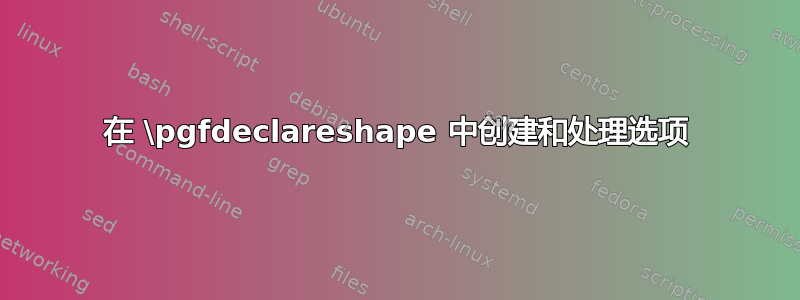
我正在开发一个小型的寄存器传输级 (RTL) 库,我将在我的博士论文中大量使用它。我正在设计一个运算符符号,它可以将一个位或一个总线作为输入和/或输出。如果是位,连接器应该画成一条细线。如果是总线,则画一条超粗线。我想创建两个选项传递给形状。我现在知道如何创建它们,但不知道如何编写如果语句来获得所需的结果。以下是相关代码片段。
\tikzset{input type/.initial={bus}} % bus or bit string values
\tikzset{output type/.initial={bus}}
\pgfdeclareshape{operator}{
...
\beforebackgroundpath{%
% Connectors are always black
\color{black}
% This is the part I'm getting problems with
% If input type is *bit*
\pgfsetlinewidth{.5pt} % <-- ideally, it should be the thin option from tikz,
% but I don't know how to set it
% If input type is *bus*
\pgfsetlinewidth{1pt} % <-- should be ultra thick option
% First input
\pgf@process{\pgfutil@useanchor{operator}{a}}
\pgfmoveto{\pgfpoint{\pgf@x}{\pgf@y}}
\pgf@process{\pgfutil@useanchor{operator}{north west}}
\pgflineto{\pgfpoint{\pgf@x}{\pgf@y}}
% Second input
\pgf@process{\pgfutil@useanchor{operator}{b}}
\pgfmoveto{\pgfpoint{\pgf@x}{\pgf@y}}
\pgf@process{\pgfutil@useanchor{operator}{south west}}
\pgflineto{\pgfpoint{\pgf@x}{\pgf@y}}
\pgfusepath{stroke}
% If output type is *bit*
\pgfsetlinewidth{.5pt}
% If output type is *bus*
\pgfsetlinewidth{1pt}
% Output
\pgf@process{\pgfutil@useanchor{operator}{r}}
\pgfmoveto{\pgfpoint{\pgf@x}{\pgf@y}}
\pgf@process{\pgfutil@useanchor{operator}{east}}
\pgflineto{\pgfpoint{\pgf@x}{\pgf@y}}
\pgfusepath{stroke}
}
...
}
这似乎是一个相当简单的解决方案,但手册太长了,到目前为止我还没有找到任何线索。提前感谢你的帮助。
答案1
不是一个完整的答案,但说明了定义形状时可以使用的技巧,以便可以将 TikZ 样式传递给 PGF 层behindbackgroundpath。这绕过了\if...\fi形状定义中复杂语句的需要,因为一切都可以使用样式完成。
在此(编辑)版本中,使用节点放置符号label。
\documentclass[tikz,border=5]{standalone}
\makeatletter
\pgfdeclareshape{operator}{
\nodeparts{}
\savedmacro\operatorparameters{%
\pgfmathsetlength\pgf@x{\pgfkeysvalueof{/pgf/minimum width}}%
\pgfmathsetlength\pgf@y{\pgfkeysvalueof{/pgf/minimum height}}%
\pgfmathsetlengthmacro\radius{max(\pgf@x,\pgf@y)/2}%
\addtosavedmacro\radius%
%
\pgfmathsetlength\pgf@x{\pgfkeysvalueof{/pgf/outer xsep}}%
\pgfmathsetlength\pgf@y{\pgfkeysvalueof{/pgf/outer ysep}}%
\pgfmathsetlengthmacro\outersep{max(\pgf@x,\pgf@y)}%
\addtosavedmacro\outersep%
}
\anchor{center}{\pgfpointorigin}%
\anchor{north}{\operatorparameters%
\pgfpointpolar{90}{\radius+\outersep}}
\anchor{south}{\operatorparameters%
\pgfpointpolar{270}{\radius+\outersep}}
\anchor{east}{\operatorparameters%
\pgfpointpolar{0}{\radius*sqrt(2)}}
\anchor{west}{\operatorparameters%
\pgfpointpolar{180}{\radius+\outersep}}%
\anchor{north west}{\operatorparameters%
\pgfpointpolar{135}{\radius*sqrt(2)}}
\anchor{south west}{\operatorparameters%
\pgfpointpolar{225}{\radius*sqrt(2)}}
\anchor{north east}{\operatorparameters%
\pgfpointpolar{45}{\radius+\outersep}}%
\anchor{south east}{\operatorparameters%
\pgfpointpolar{315}{\radius+\outersep}}%
\behindbackgroundpath{%
\operatorparameters%
\pgfpathmoveto{\pgfpointpolar{135}{\radius}}%
\pgfpathlineto{\pgfpointpolar{135}{\radius*sqrt(2)}}%
\pgfpathmoveto{\pgfpointpolar{225}{\radius}}%
\pgfpathlineto{\pgfpointpolar{225}{\radius*sqrt(2)}}%
\pgfpathmoveto{\pgfpointpolar{0}{\radius}}%
\pgfpathlineto{\pgfpointpolar{0}{\radius*sqrt(2)}}%
\pgflib@sh@operator@connectors%
}
\backgroundpath{%
\operatorparameters%
\pgfpathcircle{\pgfpointorigin}{\radius}%
}
}
\pgfkeys{/pgf/.cd,
operator connectors/.store in=\pgflib@sh@operator@connectors,
operator connectors=,
}
\tikzset{%
operator connectors/.style={
/pgf/operator connectors={\begingroup\tikzset{#1}\tikz@finish}
},
operator symbol/.style 2 args={
label={[every operator symbol/.try,#1]center:{#2}}
},
% Defaults
operator connectors={ultra thick, draw=black},
every operator symbol/.style={overlay, font=\Large},
}
\begin{document}
\begin{tikzpicture}[minimum size=1cm]
\node [shape=operator,
operator symbol={font=\Huge, scale=4, gray!50}{$\times$},
operator connectors={draw=gray, line width=0.5cm},
minimum size=2in, line width=0.5cm,
draw=gray!50] (s) {};
\foreach \name/\anchor in {center/above, north/above, south/below,
east/right, west/left, north east/above right, south east/below right,
north west/above left, south west/below left}
\draw [draw=red, shift=(s.\name)] node [\anchor] {\name}
(-.1,-.1) -- (.1,.1) (-.1,.1) -- (.1,-.1);
\end{tikzpicture}
\end{document}




